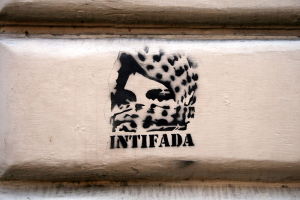As Unrest Spreads, Some Speculate A Looming Intifada
Orwa Hammad, a 14-year-old Palestinian-American, was buried Sunday in the West Bank village of Silwad, northeast of Ramallah. The New Orleans-native was killed during clashes between protesters and Israeli forces on Friday in which 12 others were reportedly injured. Israeli officials assert that the military opened fire on someone hurling Molotov cocktails, while witnesses claim Hammad had only been throwing stones.
The incident was the second fatal shooting of a Palestinian minor in eight days, following the death of 13-year-old Bahaa Sameer Mousa Bader, who was killed in the West Bank village of Beit Liqya on Oct. 16.
Orwa’s funeral was delayed until Sunday to allow Hammad’s father, a Louisiana resident, and his mother, who had been visiting relatives in Jordan, to arrive in Silwad.
State Department spokeswoman, Jen Psaki, stated that the United States "expresses its deepest condolences” to the Hammad family, and called for a "speedy and transparent investigation" into his death. Psaki also urged all parties to "restore calm and avoid escalating tensions."
The death comes amid a number of similar events in recent days. On Wednesday, a car plowed into a crowd standing at the Ammunition Hill light rail station in Jerusalem, killing three month-old Chaya Zissel Braun—she and her parents, also injured in the incident, are U.S. citizens. The driver, a 20-year-old Palestinian man from the East Jerusalem village of Silwan, Abdel-Rehman al-Shaloudi, was shot by police as he attempted to flee the scene on foot. He died a few hours later from his wounds. Eight others were injured at the scene, and one, a 22-year-old Ecuadorean tourist, has since died. Israeli officials allege that the driver had ties to Hamas, and had spent time in Israeli custody for security offenses. Al-Shaludi's family expressed certainty, however, that the incident was accidental, and that Abdel-Rahman suffered from worsening psychological issues since having been released from Israeli custody—even visiting a physician the day of the incident.
The light rail incident comes just days after the death of a five-year-old Palestinian girl, Inas Dar Khalil, who was struck by an Israeli settler on Oct. 20 after she and a schoolmate had gotten off a school bus and were making their way across the street to their mothers. The second girl, Nilin Asfour, sustained severe injuries and remains in critical condition. The driver fled the scene, claiming he feared for his life, and reported the incident to the police who ruled the hit-and-run an accident.
Palestinian Ambassador to the United Nations, Riyad Mansour, lodged a complaint with the UN Security Council in a letter that, among other grievances, cited similar hit-and-run incidents in recent weeks. Mansour referenced an Aug. 7 incident when an Israeli settler struck and injured an eight-year-old Palestinian girl, Aug. 14 when a Palestinian man was hit by a settler's car, the death of another Palestinian man who was struck on Aug. 17, and the injury of a 10-year-old girl in Silwan at the end of September.
Turmoil Upon Temple Mount
Since the brokering of an Aug. 26 agreement to indefinitely cease hostilities after 50 days of fighting, tension and violence in the region appears to have reached a fever pitch.
Since this summer's hostilities, the area around the al-Aqsa mosque has witnessed a sustained pattern of unrest, with clashes and protests becoming especially frequent over the last few weeks. Despite Israeli forces having conducted mass arrests in an attempt to contain demonstrations, unrest persists in the city, due in large part to perceived threats to the integrity of the al-Aqsa Mosque and East Jerusalem at large.
While Prime Minister Benjamin Netanyahu has insisted that Israel would not seek to change the status quo with respect to policies governing the al-Aqsa Mosque, right-wing legislators from his party are said to be intent on introducing legislation permitting Jewish prayer in, and visitation to, the Temple Mount compound. Tensions have been further exacerbated by visits by far-right Israelis, accompanied by Israeli police to the al-Aqsa grounds.
Ongoing Israeli settlement expansion into regions of the West Bank and East Jerusalem are also blamed for setting off unrest in a number of flashpoints in the region. Expanding settlements in the area are perceived as provocative and being intended to strengthen and realize Israel's claim to the entirety of Jerusalem as its "eternal and indivisible" capital.
The Second and most recent Intifida, or Palestinian uprising, was preceded by failed peace talks in 2000, followed by a visit to the Temple Mount by then-opposition candidate, Ariel Sharon, sparking explosive demonstrations and setting into motion the second widespread uprising. Examining this precedent, it is not difficult to imagine why many—from disgruntled Palestinian teenagers in the streets of Ramallah to Israeli and Palestinian officials—are increasingly worried that current unrest could very quickly devolve into more widespread violence, or even a Third Intifada.

